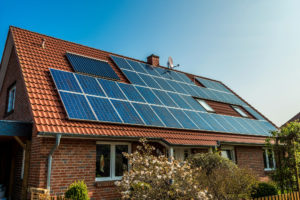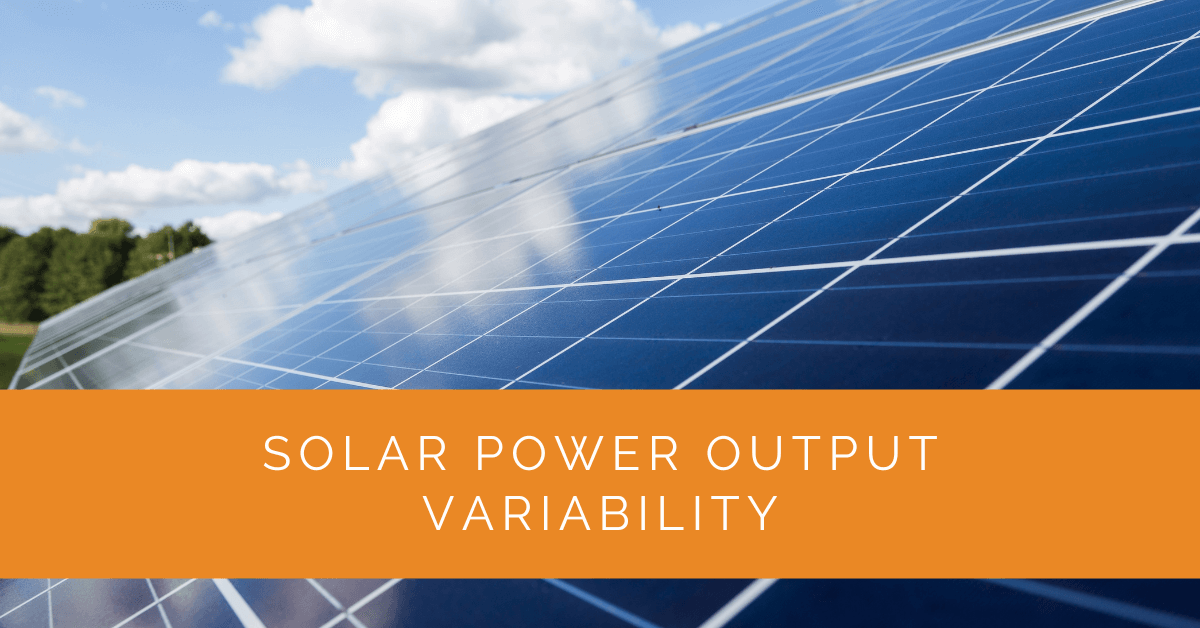Solar energy has become a particularly hot topic in recent years, and for good reason. Harnessing the power of the sun to generate electricity has become not just an environmentally friendly option but also an economically viable one. However, understanding the variability in solar power output is crucial for anyone looking to install solar panels or invest in solar energy projects. This article will delve into solar power output variability, focusing on the impact of factors such as solar radiation, temperature, and weather conditions.
Contents
- 1 Key Takeaways
- 2 Solar Power Variability
- 3 Temperature Effects on Solar Power
- 4 Monitoring Solar Power Variation
- 5 Overcoming Solar Power Variability
- 6 Case Study: Mitigating Solar Power Output Variability for a Residential Installation
- 7 Expert Insights From Our Solar Panel Installers About Understanding Solar Power Output Variability
- 8 Experience Solar Excellence with Us!
- 9 Conclusion
Key Takeaways
- Solar power output is subject to natural variations driven by daily and seasonal factors, weather conditions, and solar panel efficiency.
- Temperature plays a significant role in solar panel performance, with higher temperatures potentially leading to reduced efficiency.
- Monitoring systems, data analysis, and strategies like battery storage and grid integration can help mitigate solar power variability, making solar energy a more reliable and sustainable source of electricity.
Solar Power Variability
Solar Power Variability
Solar power variability is an inherent aspect of harnessing energy from the sun. Understanding it thoroughly is crucial for anyone considering the installation of solar panels or venturing into solar energy projects. The variability in solar power output can be attributed to several factors, including solar radiation, temperature, and weather conditions. In this section, we will delve deeper into the intricacies of solar power variability, focusing initially on the daily and seasonal changes that solar energy generation experiences.
Daily Solar Output Fluctuations
Daily solar output fluctuations are a primary consideration for solar power variability. Over a single day, solar radiation levels exhibit significant variations, with energy production reaching its peak during the midday hours when panels receive the most direct sunlight. However, the dynamics of energy generation begin to unfold early in the morning as the sun rises, and they gradually taper off in the late afternoon as the sun sets.
Seasonal Changes in Solar Power
Expanding our view beyond daily fluctuations, we encounter the equally significant realm of seasonal changes in solar power. Throughout the year, solar energy generation experiences marked variations due to the shifting angles and intensities of sunlight. Summer, characterized by longer daylight hours and a higher sun angle, naturally yields greater solar energy production. Conversely, shorter days and a lower sun angle in the winter months translate to diminished solar power output.

Temperature Effects on Solar Power
Temperature and Solar Panel Performance
The influence of temperature on solar panel performance is a topic deserving of a more profound exploration. While solar panels thrive in lower temperatures, their efficiency wanes as the mercury rises. It’s not just about the direct impact on panel performance; high temperatures also affect the overall longevity of the solar array and its components.
The Role of Inverter Temperature
Inverters, critical components of any solar energy system, play a pivotal role in translating the direct current (DC) generated by solar panels into usable alternating current (AC). The efficiency of inverters is also heavily influenced by temperature. Elevated temperatures can result in reduced inverter performance, impacting the overall output of your solar power system.
Strategies for Temperature Mitigation
Mitigating the adverse effects of temperature on solar panels and inverters requires a multifaceted approach. While proper panel orientation and shading are essential, more advanced strategies are available. Innovative cooling technologies, such as active cooling systems, can be employed to maintain optimal panel temperatures, thereby optimizing energy production.
Monitoring Solar Power Variation
Solar Power Monitoring Systems
To gain a more comprehensive understanding of solar power variation, it’s imperative to delve into the realm of solar power monitoring systems. These systems are the linchpin for effectively managing and optimizing solar energy production. They provide real-time data and insights that empower homeowners and project managers to make informed decisions.
Data Analysis for Optimization
Collecting and analyzing data on solar power output over extended periods is a crucial facet of optimization. By examining historical data, patterns, and trends can be discerned, offering invaluable insights into the dynamics of solar energy generation. With this knowledge, stakeholders can fine-tune their solar energy systems for maximum efficiency.
Predicting Solar Output
Advanced data analysis takes solar power optimization to the next level by enabling the prediction of solar output. This predictive capability is particularly beneficial for large-scale solar energy projects and grid operators. It allows for meticulous planning and resource allocation, ensuring solar power can be harnessed effectively and reliably.

Overcoming Solar Power Variability
Battery Storage Solutions
Integrating battery storage solutions is one of the most effective strategies for conquering solar power variability. These systems allow surplus energy generated during sunny periods to be stored for later use, ensuring a consistent and reliable source of electricity. While the basic concept of battery storage is clear, exploring the various technologies and their applications can provide a more comprehensive perspective.
Grid Integration and Net Metering
Grid integration represents another pivotal approach to managing solar power variability. By connecting solar energy systems to the electrical grid, surplus energy can be seamlessly fed back into the grid, enabling users to draw power when their solar panels are less productive. Net metering takes this a step further, facilitating the exchange of excess energy for credits, creating a symbiotic relationship between consumers and the grid.
Backup Power Systems
For critical applications, backup power systems come into play. These systems, which may include diesel generators or fuel cells, serve as a reliable source of electricity during periods of low solar power output. While they may not align with the sustainability goals of some solar energy enthusiasts, they provide an essential safety net for uninterrupted power supply when needed most.
By delving deeper into the various facets of solar power variability, we gain a more profound understanding of the challenges and opportunities associated with harnessing the sun’s energy. Through meticulous monitoring, advanced technologies, and strategic planning, we can continue to evolve the solar energy landscape, reducing variability and making solar power an increasingly reliable and sustainable energy source for years.
Case Study: Mitigating Solar Power Output Variability for a Residential Installation
Background
A homeowner approached us to install a solar energy system on their property. They were particularly concerned about the variability in solar power output due to fluctuating weather conditions and seasonal changes. Their goal was to achieve a reliable and efficient solar energy system that could provide consistent power throughout the year.
Project Overview
The project’s primary objective was to design and install a solar panel system that would minimize the effects of power output variability. This involved careful consideration of factors such as solar radiation, temperature, and weather conditions. Our team focused on incorporating advanced technologies and strategies to ensure consistent energy production.
Implementation
- System Design: We began by conducting a thorough site assessment to determine the optimal placement and orientation of the solar panels. This included analyzing the roof’s angle, shading patterns, and the property’s geographical location to maximize solar radiation absorption.
- Temperature Mitigation: Given the significant impact of temperature on solar panel performance, we incorporated advanced cooling technologies. We installed panels with built-in passive cooling systems and ensured proper ventilation to maintain optimal temperatures and enhance efficiency.
- Monitoring and Data Analysis: To manage power output variability effectively, we implemented a robust monitoring system. This system provided real-time data on solar panel performance, allowing us to track energy production and identify patterns or anomalies promptly.
- Battery Storage Integration: To address daily and seasonal fluctuations, we integrated a high-capacity battery storage system. This allowed excess energy generated during peak sunlight hours to be stored and used during periods of low solar radiation, ensuring a steady power supply.
- Grid Integration: We connected the solar energy system to the local electrical grid, enabling net metering. This allowed the homeowner to feed surplus energy back into the grid and receive credits, ensuring they had a reliable power source even during cloudy days or at night.
Results
- Increased Reliability: The comprehensive approach to mitigating solar power variability resulted in a highly reliable solar energy system. The homeowner experienced consistent energy production, with minimal impact from daily and seasonal fluctuations.
- Optimized Performance: The advanced cooling technologies and strategic panel placement significantly enhanced the system’s efficiency. The monitoring system provided valuable insights, allowing for timely adjustments and maintenance to ensure optimal performance.
- Energy Independence: The integration of battery storage and grid connectivity provided the homeowner with a high degree of energy independence. They could rely on their solar energy system for most of their power needs, reducing their reliance on the grid and lowering their energy bills.
- Environmental Benefits: The efficient and reliable solar energy system contributed to a substantial reduction in the homeowner’s carbon footprint. By harnessing renewable energy, they played a part in promoting sustainability and reducing greenhouse gas emissions.
Summary
This case study highlights the importance of addressing solar power output variability for achieving reliable and efficient solar energy systems. By incorporating advanced technologies such as cooling systems, monitoring, battery storage, and grid integration, we were able to optimize the performance of the residential solar installation. The homeowner now enjoys consistent energy production, reduced energy bills, and a smaller environmental footprint, demonstrating the potential of solar power as a sustainable and dependable energy source.
Expert Insights From Our Solar Panel Installers About Understanding Solar Power Output Variability
Solar power output variability is a natural aspect of solar energy systems. By understanding the factors influencing it, such as solar radiation and temperature, we can optimize system performance and ensure consistent energy production.
Senior Solar Energy Consultant
Temperature fluctuations can significantly impact solar panel efficiency. Proper installation and innovative cooling techniques are essential for maintaining optimal performance and extending the lifespan of solar panels.
Lead Solar Engineer
Monitoring and data analysis are crucial in managing solar power variability. With advanced monitoring systems, we can predict and adapt to changes, ensuring reliable energy generation for our clients.
Solar Installation Specialist
Experience Solar Excellence with Us!
Trust in Solar Panels Network USA, where our seasoned experts deliver top-quality solar solutions for homes and businesses nationwide. With a legacy of countless successful installations and a commitment to sustainable energy, we’re your reliable partner in the solar journey. Ready for a brighter, eco-friendly future? Call us now at (855) 427-0058 and harness the power of the sun!
Conclusion
Solar power output variability is a natural aspect of solar energy generation. It is influenced by solar radiation, temperature, and weather conditions. Understanding these variations and implementing strategies to mitigate their effects is essential to maximize solar energy. With proper monitoring, data analysis, and the use of technologies like battery storage and grid integration, solar power can become a reliable and sustainable source of electricity for years to come.
Solar energy has the potential to distribute electricity across the US, and as technology continues to advance, we can expect to see even less variability in solar power output. By investing in solar energy projects and optimizing solar panel installations, we can reduce the impact of variation and think about solar power as a base-load energy source for the future.
About the Author
Solar Panels Network USA stands at the forefront of solar energy solutions, driven by a team of seasoned solar engineers and energy consultants. With over decades of experience in delivering high-quality solar installations and maintenance, we are committed to promoting sustainable energy through customer-centric, tailored solutions. Our articles reflect this commitment, crafted collaboratively by experts to provide accurate, up-to-date insights into solar technology, ensuring our readers are well-informed and empowered in their solar energy decisions.

